Expanding your Amazon Brand to Europe: A Step by Step Guide
If you sell your products on the US Amazon marketplace through Seller Central, you’ve probably been encouraged by Amazon to expand to other Amazon marketplaces, including Amazon UK, Amazon Germany, and Amazon France, Italy and Spain.
Amazon makes it seem easy to expand to Europe… and the first step of setting up your brand in additional Amazon marketplaces is indeed the easy part. But beyond that, it can quickly get complicated, with unexpected costs and compliance steps.
That’s why expanding to multiple Amazon marketplaces isn’t right for every brand.
Here’s a brief overview of the steps involved. This isn’t meant to be a complete tutorial, but an outline to give you an understanding of what to expect.
We can help with everything here, and we have an office in Kerry, Ireland that specializes in expanding US Amazon businesses to Amazon Europe. Let’s set up a call if you’d like to learn more.
1. Market and Competitor Research
Identifying Suitability for the Market
- Assess the compatibility of your products with European marketplaces, and identify potential modifications to align with local preferences and standards
Revenue Estimation
- Analyze and estimate the potential additional revenue in comparison to the U.S market.
Competitor Analysis
- Research competitors, especially those with a presence in both U.S. and Europe.
- Understand their strategies and market positioning.
- We just did the CUTEST social media images for Naavi and we had to show them off.
 Sometimes it’s the little things… like Chihuahuas!
Sometimes it’s the little things… like Chihuahuas!
2. Product and Packaging Compliance
EU and UK Regulations
- Determine the relevant EU and UK regulations and standards that apply to your products.
- Ensure compliance to avoid legal and operational challenges.
Packaging Adjustments
- Modify packaging to meet language requirements and other local specifications.
3. Setting Up a European Account
Account Registration
- Sign up for a Europe Seller Central account using the same primary email as the North American account for continuity.
VAT and EORI Registration
- Begin the process of VAT (Value Added Tax) and EORI (Economic Operators Registration and Identification) registration. This is crucial for legal and tax purposes.
Partnering with Packaging Firms
- Register with packaging partners in countries with strict packaging waste regulations like Germany and France.
4. Pricing Strategy
Cost Consideration
- Determine pricing by factoring in additional costs such as VAT, higher shipping costs, etc.
5. Product Listing and Localization
ASIN Migration
- Migrate ASINs (Amazon Standard Identification Numbers) to the UK market, the most common first step in expansion for US brands.
- Localize the English language where necessary to suit local nuances.
Expansion to Other Markets
- List products in other identified European markets after thorough research.
Localized Keyword Research
- Conduct localized keyword research for backend optimization, future ad campaigns, and potential content modifications.
Localization Partnerships
- Work with local partners to ensure accurate and culturally relevant localization. Google Translate usually isn’t sufficient.
6. Logistics and Shipping
VAT and EORI Completion
- Once VAT and EORI numbers are available, coordinate with shipping and customs partners for efficient logistics.
7. Ongoing Account Management
Take a Consistent Approach
- Maintain the same level of account management as in the U.S marketplace, ensuring consistency in service quality.
In conclusion, expanding into the European market requires a blend of strategic planning, regulatory compliance, and localization efforts. By following these steps, businesses can successfully establish their presence in Europe, tapping into new customer bases and revenue streams.
More from Parker-Lambert
- Amazon’s New “Buy for Me” Feature: What DTC Brands Should Know
 If you’re a DTC brand that’s been dodging Seller Central like a bad ex, Amazon might have a new reason for you to take their calls again.
If you’re a DTC brand that’s been dodging Seller Central like a bad ex, Amazon might have a new reason for you to take their calls again. - We just did the CUTEST social media images for Naavi and we had to show them off.
 Sometimes it’s the little things… like Chihuahuas!
Sometimes it’s the little things… like Chihuahuas! - Amazon Case Study: Hydros Water Filter System
 Hydros had a great product line with a happy and growing customer base both on and off Amazon, but they weren’t satisfied with their overall Amazon business performance. Here’s how we helped.
Hydros had a great product line with a happy and growing customer base both on and off Amazon, but they weren’t satisfied with their overall Amazon business performance. Here’s how we helped. - Amazon is automatically updating product content. Here’s what to do.
 Amazon has begun automatically updating product content. It’s not yet rolled out for most sellers at the time of this writing, but you’ll want to check to see whether it’s been activated for your brands.
Amazon has begun automatically updating product content. It’s not yet rolled out for most sellers at the time of this writing, but you’ll want to check to see whether it’s been activated for your brands. - How we helped a hardware brand save 90% on their lifestyle photography
 When we helped RCH Hardware improve their Amazon presence for their line of hanging and decorative chains, we had to tackle the problem of their limited library of lifestyle photography. Guess how we did it?
When we helped RCH Hardware improve their Amazon presence for their line of hanging and decorative chains, we had to tackle the problem of their limited library of lifestyle photography. Guess how we did it?







